Brewing your own vossaøl

The gear |
To better understand why vossaøl tastes the way it does I wanted to try to brew it with modern homebrewing equipment. So I teamed up with my friend Geir Ove Grønmo, who is an experienced homebrewer and had all the equipment we needed. The recipe is simplicity itself: pure pilsner malts, some noble hops, kveik (yeast). The biggest challenge is that the whole process takes so long.
The first step was to find juniper. Where is there juniper near Oslo? I had no idea, but internet searching told me it should be here. One evening when I was alone with my daughter we went into the forest to a place where she said there would be juniper. On the way we learned that she (being 6) had no idea what juniper looks like. Still, I had no idea where to look, so we might as well look where she suggested. And after about 20 minutes we did find one small bedraggled bush. It was so scrawny I didn't want to use it, but after searching another 5 minutes I found one that was just barely usable. Enough to fill up a small plastic bag with juniper.
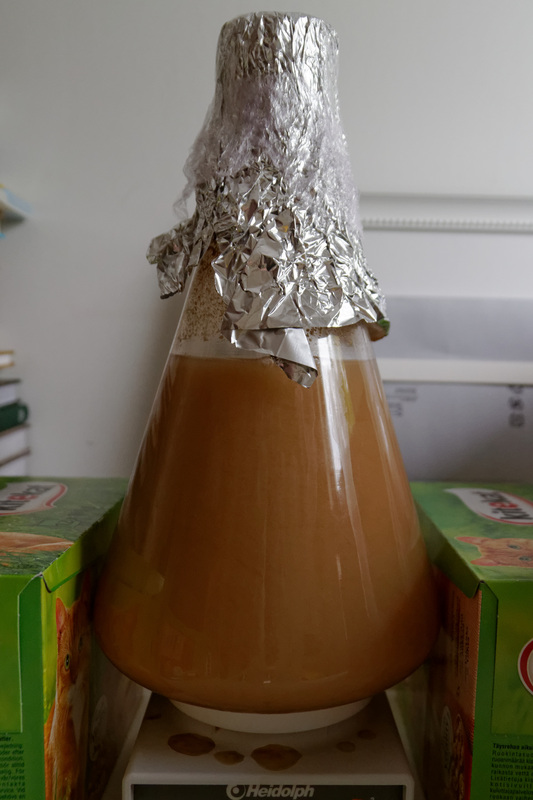
Yeast starter |
The second step was to grow the kveik (yeast). I had a small 50ml bottle I got from Sigmund, but this wouldn't be enough for our 20-litre batch. Geir Ove has a magnetic stir plate, so I gave him the yeast a few days in advance, and he was able to grow a good starter culture for us. He grew in two steps: first with 500ml yeast nutrient for 3 days, then with 1500ml for a little over a day. At the end of this we had about 0.1 liter of slurry at the bottom of the flask.
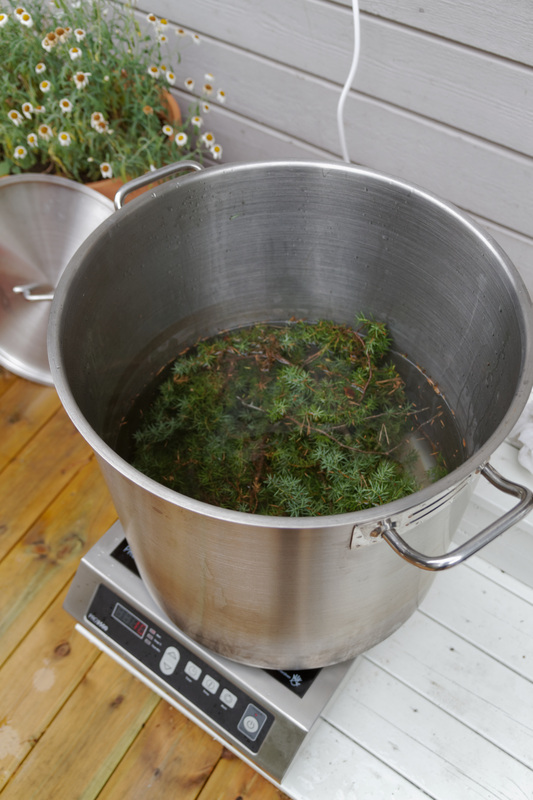
Making juniper infusion |
With that out of the way, we were ready to start. First, we made juniper infusion for the mashing. That is, we put juniper branches into the kettle, then heated the water to about 85C. At this point it became obvious why Sigmund was using a sieve. The infusion was full of all kinds of dirt, including a ladybug. We fished out a good deal of it using a kitchen sieve, but there was no way to get it all.
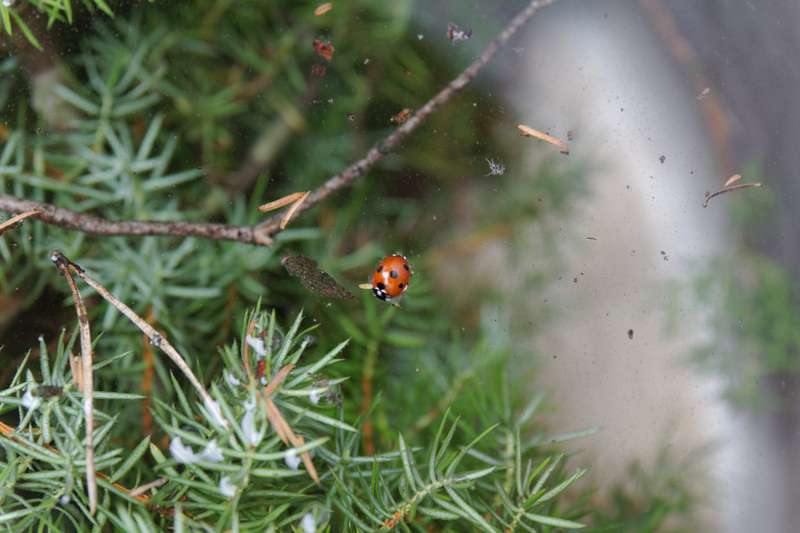
Infusion with ladybug |
Anyway, once the water was heated, we were ready to mash. Traditionally, the farmhouse brewers use juniper branches at the bottom of the mashtun, to act as a filter. Geir Ove's mash box already has a filter, but we threw a branch in there anyway, to stay as close to the traditional approach as possible. We poured on hot juniper infusion until the temperature was 68C, threw in half the hops, stirred a bit, then closed the lid and let it sit. In Voss brewers mash 3-4 hours, but we didn't have time for that, so we waited about 1.5 hours, then opened the lid so the temperature could drop. After another 30 minutes the temperature was down to about 58C, and we stopped.
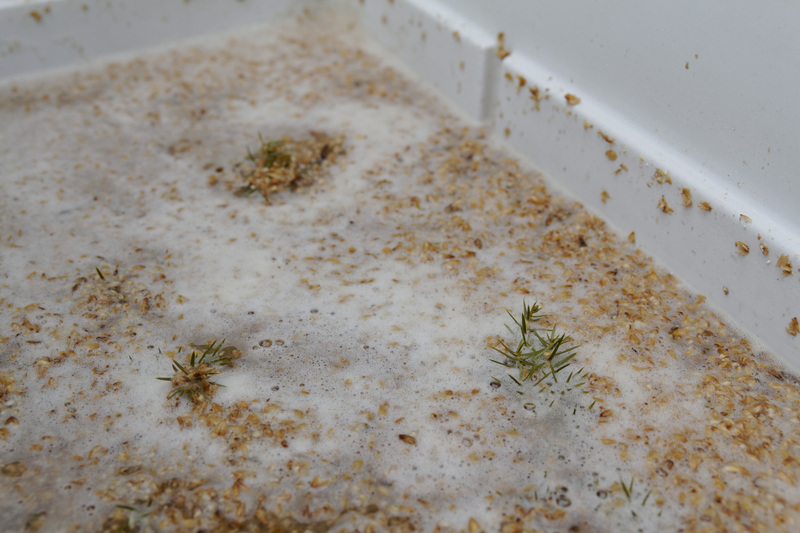
The mash |
Next step: the running. The traditional way to do this is excruciatingly slow, but we didn't have to worry about clogging the outlet, so we just ran it off very quickly. To get enough wort we poured more hot juniper infusion into the mash. Eventually we had about 40 liters of wort, at an OG of 1041. Then it was time for the boil.
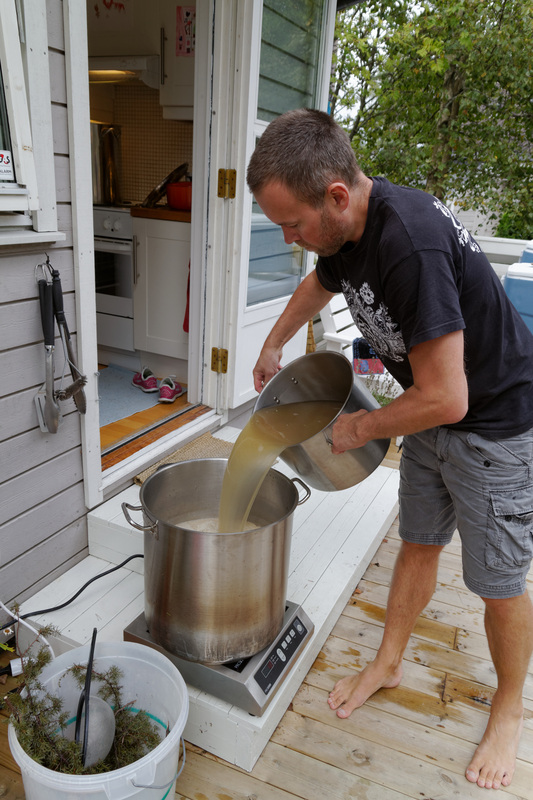
Ready to boil |
At this point, tradition calls for a wood-fired copper kettle, but we didn't have that. Instead, we used electric heating and a steel kettle. Where we did follow tradition was in the length of the boil: 4 hours, boiling away fairly exactly half the wort. After the mashing a lot of the dirt in the wort was gone, and during the boil we used the sieve to remove "the headache" (that is, the coagulated protein on the surface) and any remaining dirt. 15 minutes before the end we added the other half of the hops. At the end of the boil all the dirt was gone, and we had a clean wort with an OG of 1081.

Pitching |
Then it was time for the kveik. True to tradition, we started by tasting it. It was very watery, but there was the familiar orange peel and spice flavour. No sign of acidity, or other problems. Before pitching we used Geir Ove's home made wort cooler to cool down the wort. Usually Geir Ove pitches the yeast at 20C, but now we were going to do it at 40C. As it turned out, the temperature fell of quicker than expected, and by the time Geir Ove had found his thermometer the wort was down at 35C.
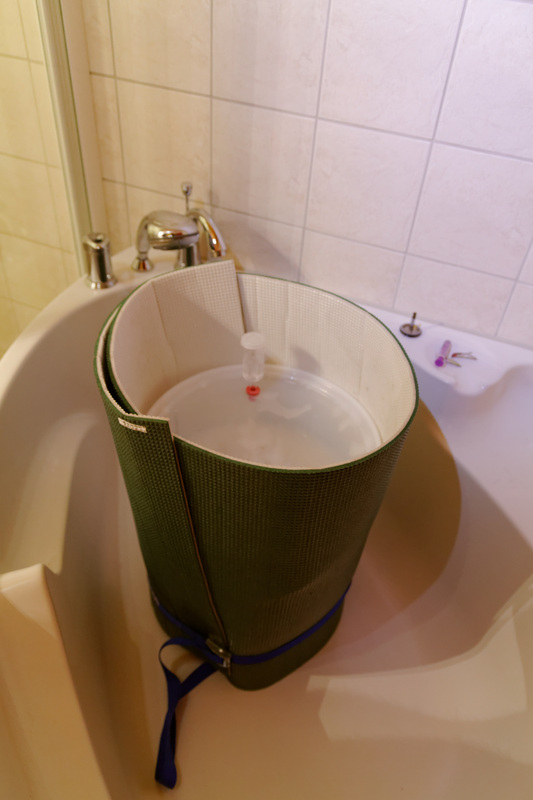
Insulated fermenter |
We pitched anyway, and put the fermenter in the bathroom, since that was the warmest room in the house. To help keep the temperature up we wrapped the fermenter in a camping mat, and put a fleece sweater on top. Under the sweater, on top of the fermenter, Geir Ove put a thermometer to keep track of what happened. The results are in the table below.
| When | Temperature |
|---|---|
| Sunday night | 32 |
| Monday morning | 35 |
| Monday afternoon | 36 |
| Tuesday morning | 34 |
| Tuesday afternoon | 30 |
| Tuesday night | 28.5 |
| Wednesday afternoon | 27 |
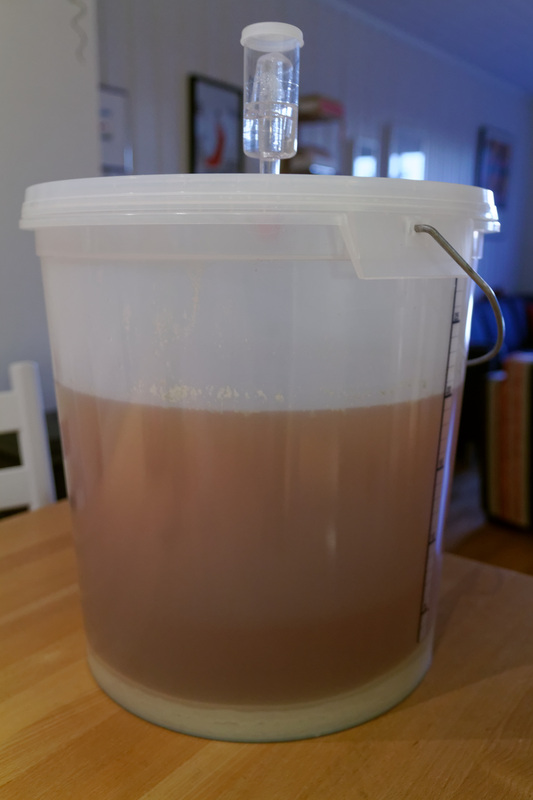
After fermentation (note trub at bottom) |
We brewed on Sunday and pitched Sunday evening. By Tuesday night most of the fermentation was done, as you can see from the table. We stuck to tradition and bottled and kegged the beer on Thursday evening. Which is crazily fast. Geir Ove had brewed a double IPA at the same time on Sunday, and when we bottled the vossaøl the IIPA was still bubbling away. Kveik, fermenting 20 degrees warmer, is a fast worker.
Anyway, since we tapped the beer with a hose the slurry at the bottom was undisturbed. Thus, we could use a ladle and a funnel to transfer the slurry into more 50ml bottles and a couple of bigger glasses. And thus we had another generation of kveik, and I could fulfill my promises of sharing kveik. What we were doing was really microbiology, an operation professional breweries use labs and microcopes for. For us a funnel and a ladle would have to do.
So far I've tasted the result twice. Once a week after bottling, and once two weeks after. It's hazy and pale, unsurprisingly, with no real head, since there's no carbonation. The aroma is fruity yeasty Christmas spice, with traces of juniper. The taste is sweetish mealy juniper and oranges with Christmas spice notes. There's a kind of mealy, minty, grainy quality to it that I really enjoy, and the juniper flavour mixes in with the oranges just right. It's very well balanced, and easy to drink. The 8.8% alcohol is not really noticeable. Overall an excellent beer that stands up well in comparisons with commercial beers. I'm not ashamed to say this, since I neither wrote the recipe, nor brewed the beer. I simply helped Geir Ove as we replicated Sigmund's recipe as exactly as we could.
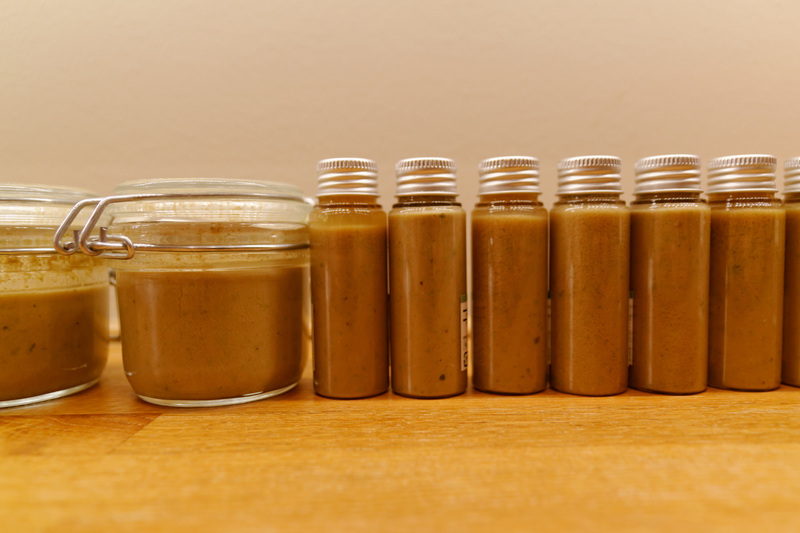
Kveik |
The big question, of course, is how it compares with Sigmund's beer. I will find that out on Thursday, when I'm going to taste a bottle of his beer next to a bottle of the beer we brewed. More details then.
The day after we brewed the beer I was walking home from the train station after work, when my nose suddenly caught a familiar aroma: juniper! I looked around and quickly spotted a big circular hedge of juniper, right in the middle of a roundabout. I've walked past it every day for about four years, but never noticed. Not that it's much help: that roundabout sees such heavy traffic it would be suicide to venture out there.
Recipe
More details on the recipe:
- Juniper branches.
- 7.5 kilos of pilsner malts for 20 liters of wort (after boiling).
- 30 grams of Saaz hops
- 25 grams of Hallertauer Mittelfrüh
- OG after mash 1041, after boil 1081.
- Pitch at 35C (by accident, should have been 40C). Fermented for four days.
- Kveik yeast is essential.
- FG of 1014, giving an ABV of 8.8%.
If you want even more detail you can see the recipe on BeerCalc.
Anyway, the conclusion is that you can brew a passable imitation of vossaøl fairly easily, provided you have the yeast. I'm hoping to make that available via The Yeast Bay, after tips from people on Reddit. More on this later.
Similar posts
RBNAG '07
The title probably makes it sound as though I've been to yet another IT conference, but this was actually something completely different
Read | 2007-11-06 23:58
Geir Ove Becomes a Blogger
My friend and Ontopian colleague Geir Ove Grønmo (yes, he of the fridge and the typed data) has started his very own beer blog
Read | 2006-08-17 20:49
Beer temperature: really getting it right
Some people care more about the temperature of their beers than others, and my friend Geir Ove has gone further than most
Read | 2006-07-15 15:01
Comments
Dave Pawson - 2014-09-22 12:29:46
"One evening when I was alone with my daughter we went into the forest to a place where she said there would be juniper. On the way we learned that she (being 6) had no idea what juniper looks like. Still, I had no idea where to look, so we might as well look where she suggested."
Love it Lars!
Jan - 2014-09-23 04:48:44
You can use unfiltered applejuice for a yeast starter. It has everything the yeast needs and is way cheaper than the other stuff. We used applejuice exclusively when I was working for a big german brewery. Otherwise very interesting - I might give it a try someday! Keep up the traditional stuff!
Skål from Germany,
Jan
Lars Marius - 2014-09-23 04:56:30
@Dave: Thank you. :)
@Jan: That's interesting, and worth knowing. It may well be how farmhouse brewers started their cultures centuries ago. However, for this beer it would not be the right choice, since the whole character of the beer is totally dominated by the yeast profile, which is very specific to kveik from Voss.
Jan - 2014-09-23 06:26:09
@Lars: I start the yeast for my pizza-dough with applejuice. It seems the yeast consumes all the flavour. But you are right with your specific strain of yeast - it might be spoiled by applejuice. Is it pure yeast? Or is there something else in it? The high alcohol content seems to indicate a very well adapted strain.
Lars Marius - 2014-09-23 06:32:38
@Jan: This is a yeast strain that's been in use in Voss for nobody knows how long, but very likely for centuries. So very likely exchanges between brewers has bred a strain that works well in this specific environment.
I've written a blog post about this type of yeast in general, and another specifically about where I got this yeast. I hope those explain more.
Sam - 2014-09-25 12:23:36
I'm very excited to hear that this kviek may become available via the yeast bay. If it does I will surely buy some. Are there any plans to make Lithuanian farmhouse yeast available too?
Lars Marius - 2014-09-25 12:31:52
@Sam: I will try, but the Lithuanian yeast is harder. In many parts of Lithuania brewers are very secretive about their yeast. Ramunas Cizas wouldn't even let his wife go near it, for example, and totally refused to talk about it. To make it available via The Yeast Bay I would have to obtain the consent of the brewers first, and I don't know if I could do that. But I will try.
Preserving the yeast for posterity and research at the NCYC is an entirely different proposition. For that I just need a bottle of Jovaru Alus, which I definitely will get hold of at some point. Either by having Lithuanian friends mail to NCYC or do it myself the next time I'm there.
Kristian - 2015-06-13 13:55:33
Hello!
I've gotten my hans on so8me kveik, and are eager to try it out. How did your brew turn out? In another post (http://www.garshol.priv.no/blog/293.html your wrote that many other beers "(...) with juniper infusion have had a harsh, grating quality to the bitterness, so it may be that using juniper infusion in modern equipment and batch sizes is difficult." Did this also happen to you?
Lars Marius - 2015-06-13 14:01:50
@Kristian: I've brewed two brews now with juniper on modern homebrewing equipment, and it hasn't been a problem at all. So I'm not sure what's going on with those commercial beers.
Kristian - 2015-06-14 05:00:58
@Lars Marius: That's great to hear! I will try to follow your process as much as possible. So you used about one plastic bag of juniper branches (just the tip) for 40 liters pre boil? I'm thinking I will cool down to 40 C and pitch the kveik, then let it sit in a room of about 30 degrees. Is there anything you would have done different from this first recipe?
Lars Marius - 2015-06-14 05:05:05
@Kristian: The photo shows pretty well how much juniper we used. You want to fill the water pretty well, without squeezing the branches together. For fermentation that sounds about right. I think our beer came out pretty well, but the main thing I would have changed was to use gas heating instead of electric. It gives more caramelization.
Paul - 2016-02-21 21:19:20
I love your posts. I'm a homebrewer and VP of the Rimrock Brewers Guild. I'm a tremendous fan of farmhouse ales and discovering your blog has been fantastic. I just brewed my own interpretation of the Voss ale you described. I used the Kveik from the Yeast Bay. I have brewed several Belgian farmhouse ales so I used that experience with this Norwegian beer. I added a few other malts to compensate a little for the expected attenuation. I added some caramunich malt, Munich malt, and a dash of carafa for color. It is still in the fermenter, but bubbling along nicely. I suspect final ABV to be around 8%. Thanks for the great writing.
bjørn eggen - 2016-04-19 09:12:49
Hei Forsøkte meg på denne resepten og den ga ølet et tydelig preg/smak av einer. Er det slik ditt øl også ble? Etter det jeg husker fra Voss var det ikke slik smak på Ølet
Lars Marius Garshol - 2016-04-19 09:25:28
@Bjørn: Ja, denne oppskriften gir tydelig einersmak. De ølene jeg smakte på Voss hadde det. Men hvis du vil ha mindre einersmak kan du jo bare bruke mindre einer i einerlågen.
Stephen - 2017-03-30 16:46:10
The link to the Beercalc recipe is dead and I was unable to find it through the search feature, so I have a few questions. About how many Kilos of juniper branches did you use? Did you split both the Saaz and Hallertauer Mittelfrüh in the mash and the boil, or did you put one in the mash and one in the boil?
Lars Marius Garshol - 2017-03-30 17:25:48
@Stephen: Sorry about the Beercalc link. That recipe seems to be gone forever, unfortunately. We foolishly did not measure the amount of juniper in any way, but we did fill the kettle up pretty well, as you can see in the photo. The resulting beer doesn't really have any discernible hop flavour, so it doesn't matter which hop you put where. Just sprinkle a little hops in the mash, and leave most for the boil. If you don't do the six-hour mash you don't really need hops in the mash at all and can put everything in the boil.
Andrew - 2017-12-22 17:02:29
Hi Lars,
Devouring this blog, what an excellent gift to the brewing community. I'm thinking of attempting a homebrew version of this with the kveik yeast strain that's available now, but I have a few questions.
First, should I use a different fermenter than I use for my "clean" beers? I've heard certain farmhouse strains will be hard to clean out of a vessel, and often contaminate clean styles when used again. Is this the same for kveik?
Second, has anyone tried using local fruits or berries in this style? I saw one recipe out there than uses elderberries or lingonberries in a "Scandinavian" style saison, and was possibly looking to try that out. I've also seen a lot of farmhouse breweries here in the US have a lot of success with fermented fruits.
Thanks for any help!
Lars Marius Garshol - 2017-12-23 10:12:35
@Andrew: You don't need to use a separate fermenter. Lots of modern homebrewers have brewed with kveik and switched back to normal yeast afterwards with no problems. I think you're probably thinking of Brettanomyces, which can be very hard to get out of fermenters, particularly wooden ones, but this is normal Saccharomyces cerevisiae.
If you want to add fruit/berries you can of course do that, but I think it's kind of a shame to do that the first time, since you miss out on what makes this style special. If anyone asks you what vossaøl is like you'll have to answer "I don't know, since I put lingonberries in mine." :)
Do make sure to use juniper branches, though. Juniperus communis.
Andrew - 2017-12-26 15:30:11
Good point! I'll just give the recipe a go the way its meant to be :)
Thanks Lars, and keep it up with this great blog!
Erik Johnson - 2018-09-28 10:59:54
I'm curious as to the amount of juniper branches needed to make the infusion. I live in the Southern United States and we have juniper here but it's not very plentiful as the berries seldom survive the summer and thus don't mature to make new plants. For this reason I don't wish to take more than is absolutely necessary to brew this beer, but I am keen to try.
Jonas - 2019-08-10 16:44:24
I think Lars' measurement of "fill the kettle" is accurate enough. The flavour is quite subtle to me, what I really like is the mouthfeel.
If you have a hard time sourcing juniper you can get away with using less if you boil it.
Ras - 2020-09-18 04:48:30
Hello, great article! Did you prime when bottling? If so, to how much CO2 volume were you aiming for? Thanks!
Lars Marius Garshol - 2020-09-20 12:21:00
@Ras: Thank you. Vossaøl generally has very low carbonation, so we did not prime.
Foucaud Josué - 2021-05-01 13:44:45
Hi, great blog. I'm really impressed by your work and all the research you've done. I started homebrewing about two years ago to make something that I couldn't buy at the beer store and your blog inspires me to do so even more ! I'll be making my first batch of vossaol in two weeks but I don't have any Saaz hops, I was wondering if I could instead only use Hallertauer Mittelfrüh pellets (I could order some if really needed)
Thanks !
Mick Considine - 2021-06-10 08:47:32
Hi Lars, can you please shed light on how much juniper per litre to steep before use in the mash liquor for this recipe or some of the low/zero hop recipes of of your book? Cheers
Lars Marius Garshol - 2021-06-11 11:56:22
@Mick: It seems like the suitable amount varies with your local juniper, but something like 5-10g per liter seems reasonable.
Marc - 2024-03-07 22:52:50
I was lucky enough to brew with a traditional brewer at his farm in Voss. He sent me home with some of his yeast and was sure to mention that commercial versions usually contain one Kviek yeast strain while what we used contains as many as 15 and traditional beers taste very different from one farm to the next due to the blend of natural yeasts. He also recommended that I use about .10 kilograms of smoked malt to replicate the wood fire and the copious smoke in the Eldhuset (Norwegian for firehouse or brew room).